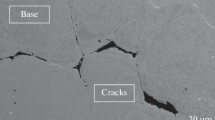Abstract
Interaction of Pr/Dy with oxygen in nickel melts at PAr = 0.1 MPa and constant temperature was studied using the EMF instantaneous fixing method using a Mo[Cr/Cr2O3//ZrO2(MgO)//O(Nil)]Mo cell and certified sensors. Dependences a[O] = f[Pr/Dy, %] expressed in the form of logarithmic equations made it possible to compare them with each other in the concentration range of 0.001–0.2 wt % of each deoxidizer and determine that the deoxidizing ability of Pr is 1.7 times higher compared to Dy. The activity of oxygen a[O] in Ni–O–Al–(Pr/Dy) melts was calculated in comparison with Al at a concentration of 0.05 wt % of elements and its sevenfold decrease was shown for the first deoxidizer and elevenfold for the second. The morphology of nonmetallic inclusions in metallographic sections of Ni–O–Pr/Dy alloys has been studied, indicating that the inclusions are located along grain boundaries and have different configurations and a complex heterophase composition. Analysis of nonmetallic inclusions with the maximum content of deoxidizing element proved the existence of Pr/Dy oxygen compounds, which confirmed the data of thermodynamic and mass spectrometric studies. The average content of Zr in nonmetallic inclusions during the deoxidation of Pr is two times higher than in experiments during the deoxidation of Dy, which indicates the interaction of Pr/Dy with the EMF ZrO2 sensor and the preferential interaction of Pr compared to Dy and correlates with the data on the determination of a[O].







Similar content being viewed by others
REFERENCES
Sidorov, V.V., Kablov, D.E., Chabina, E.B., Ospennikova, O.G., Simonov, V.N., and Puchkov, Yu.A., Vliyanie primesei i mikrolegirovaniya na strukturu i ekspluatatsionnye svoistva monokristallov zharoprochnykh nikelevykh splavov (Influence of Impurities and Microalloying on the Structure and Operational Properties of Single Crystals of Heat-Resistant Nickel Alloys), Moscow: Vseross. Inst. Aviats. Mater., 2020.
Sidorov, V.V., Rigin, V.E., and Burtsev, V.T., Features of smelting rhenium-containing carbon-free heat-resistant alloys for casting singlecrystal GTE blades, in Liteinye zharoprochnye splavy. Effekt S.T. Kishkina (Casting Heat-Resistant Alloys. The Effect of S.T. Kishkin), Moscow: Nauka, 2006, pp. 161–171.
Averin, V.V., Development of studies of the solubility and activity of oxygen in liquid metal melts, in Fundamental’nye issledovaniya fizikokhimii metallicheskikh rasplavov (Fundamental Research in the Physical Chemistry of Metal Melts), Lyakishev, N.P., Ed., Moscow: Akademkniga, 2002, pp. 34–38.
Kulikov, I.S., Raskislenie metallov (Metal Deoxidation), Moscow: Metallurgiya, 1975.
Buzek, Z., Fundamental Thermodynamic Data on Metallurgical Reactions and Interactions of Elements in System Significant for Metallurgical Theory and Practice, Ostrava: Vyzkumny Ustav Hutnictvi Zeleza, 1979.
Burtsev, V.T., Oxygen activity in nickel melts, containing Mg, Al, Y and rare earth elements, under P Ar = 0.1 MPa, Probl. Chern. Metall. Materialoved., 2018, no. 4, pp. 5–11.
Burtsev, V.T., Activity of oxygen in nickel melts containing aluminum, lanthanum and cerium at P Ar = 0.1 MPA, Rasplavy, 2018, no. 6, pp. 634–641.
Diagrammy sostoyaniya dvoinykh metallicheskikh system (Phase Diagrams of Binary Metallic Systems), Lyakishev, N.P., Ed., Moscow: Mashinostroenie, 2001, vol. 3, book 1.
Gase und Kohlenstoff in Metallen, Fromm, E. and Gebhardt, E., Eds., Berlin–Heidelberg: Springer-Verlag, 1976.
Karapet’yants, M.Kh. and Karapet’yants, M.L., Osnovnye termodinamicheskie konstanty neorganicheskikh i organicheskikh veshchestv (Basic Thermodynamic Constants of Inorganic and Organic Substances), Moscow: Khimiya, 1968.
Glushko, V.P., Termicheskie konstanty veshchestv: Spravochnik (Thermal Constants of Substances: Handbook), Moscow: VINITI, 1978, no. 8, part 1.
Kazenas, E.K. and Tsvetkov, Yu.V., Termodinamika ispareniya oksidov (Thermodynamics of Oxide Evaporation), Moscow: LKI, 2007.
Bakradze, M.M., Arginbaeva, E.G., Petrushin, N.V., and Ovsepyan, S.V., Aspects of the development of casting nickel and intermetallide alloys. Technology of manufacturing GTE details, Nov. Materialoved. Nauka Tekh., 2017, nos. 5–6 (28), pp. 3–13.
Morachevskii, A.G., Voronin, G.F., Geiderikh, V.A., and Kutsenok, I.B., Elektrokhimicheskie Metody Issledovaniya v Termodinamike Metallicheskikh Sistem (Electrochemical Research Methods in Thermodynamics of Metal Systems), Moscow: Akademkniga, 2003.
Kemori, N., Katayama, K., and Kozuka, Z., Solubility limit and thermodynamic properties of oxygen in liquid nickel, J. Chem. Thermodyn., 1981, vol. 13, no. 4, pp. 313–325. https://doi.org/10.1016/0021-9614(81)90021-5
Pluschkell, W. and Steffen, R., Elektrochemishe Sauerstoffmessung in der Metallurgie, Dusseldorf: VDEh, 1985.
Turkdogan, E.T., Physical Chemistry of High Temperature Technology, New York: Academic, 1980.
Maes, R., Application of Celox Hoods in Steel Making, New York: Heraeus Electro-Nite Int., 2000.
ACKNOWLEDGMENTS
We are grateful to A.A. Rakitin for his assistance in conducting the research.
Funding
This work was supported by the Russian Foundation for Basic Research, grant no. 19-08-00461.
Author information
Authors and Affiliations
Corresponding authors
Ethics declarations
The authors of this work declare that they have no conflicts of interest.
Additional information
Translated by V. Selikhanovich
Publisher’s Note.
Pleiades Publishing remains neutral with regard to jurisdictional claims in published maps and institutional affiliations.
Rights and permissions
About this article
Cite this article
Burtsev, V.T., Chabina, E.B. & Anuchkin, S.N. Interaction of Praseodymium and Dysprosium with Oxygen in Nickel Melts at PAr = 0.1 MPa and Analysis of Nonmetallic Inclusions. Inorg. Mater. Appl. Res. 15, 831–841 (2024). https://doi.org/10.1134/S2075113324700278
Received:
Revised:
Accepted:
Published:
Issue Date:
DOI: https://doi.org/10.1134/S2075113324700278




